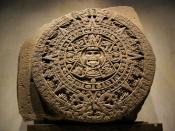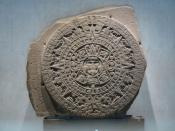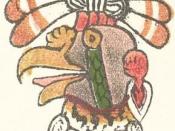The Aztec Calendar is a monument to the god Tonatiuh, the fifth sun. It was sculpted during the IV Aztec Emperor Azayacatl?s rule, in the year 13 Acatl that corresponds to 1479, and was placed in the Templo Mayor. In 1521, after the Spaniards overpowered the Aztecs, came the destruction of their idols. Fray Alonso Montufar ordered the calendar to be buried. In 1790 if was discovered and placed in the occidental part of a Cathedral, and in 1885, was sent to the Museum of Anthropology in Mexico, City.
The Aztec Calendar is a large 12 foot circular monument of painted limestone weighing over 20 tons, is made up of a series of rings. The Aztecs developed their calendar by using the sacred numbers of 20 and 13. The tonalpohualli, as it was called, consisted of 20 day signs that were used with a cycle of 13 digits for a total of 260 days.
The number 20 was special because that was the total number of fingers and toes on people. The number 13 was the total number of ancient Mesoamerican gods. This 260-day cycle was used along with the natural year that was following the seasons, beginning with Spring. The natural year had a cycle of 365 days created with 20 months of 18 days each. The final 5 days belonged to no month and were very sacred. When both cycles ended and coincided on the last day, a cycle of 52 years was over. This cycle is called the calendar round. This was a time of great celebration as the culture had been allowed another cycle of life by the gods.
Technology and civilization have an important relationship in the Stone Calendar of the Aztecs. The elaborately carved figures in the Calendar were used as tribute to the...


